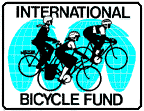Developing A Bicycle Map
WE WOULD LOVE
YOUR SUPPORT!
Our content is
provided free
as
a public service!
![]() IBF is 100%
IBF is 100%
solar powered
![]()
[Note: to find a bicycle map of a particular city go to www.google.com/search?hl=en&lr=&q=%22bicycle+map%22+city, replace "city" in the URL with the location you are looking for.]
By educating and increasing the confidence of bicyclists and potential cyclists, bicycle maps help to encourage additional bicycling. The maps that we see today have their roots in a resurgence of interest in bicycling in the 1960's and 70's.
What is the "right" bike map for any given community is very subjective. Some factors which distinguish maps are: stated purpose, scale, level of graphic effort (or expertise), type of medium (paper or plastic), size and format, symbol use, field research approach and distribution system. Of course the final product depends upon what kind of resources the producers have to devote to the project and what kind of information you want to convey.
At some point of the process there is question of quantity or quality -- a full range of options exist: A map for a two-hour group ride can be drawn on 8 1/2" x 11" paper and photocopied. If your goal is to let everyone in town know that "bicycling works" by giving away maps, after an initial investment, a GIS-based (Geographic Information System) product, printed on paper is easy to update and relatively inexpensive to print, but lacks top quality. The high end extreme is a high resolution cartographer drawn map, printed on Tyvek that will last for years and has brilliant detail, but both initial production, and updating and reprinting cost are several times as high.
Generally bike maps are divided into three categories: suitability, directional and hybrid.
Suitability maps classify roads for their bicycle-friendliness, or suitability for riding. This kind of map tends to lend itself to rural areas, without a high density of roads but where all the roads might be a candidate for bicycle travel and knowing conditions on different roads will help cyclist choose routes that meet there needs. Classification systems can take into account lane width, traffic speed, traffic volume, heavy vehicle traffic, shoulder width, topography.
Directional maps show selected preferred routes for bicycle trips, ride or tour. This kind of maps tends to lend itself to rides or tours with a specific itinerary, or to urban areas with a high density of roads. Highlighting every residential street in an urban area will dilute the usefulness of the map. At the other extreme, usually, these maps have to be more than just an inventory of signed "bicycle routes" because generally these are too few and fare between, and these designated routes may have little relevance to where cyclist really want to go. An urban directional bike map is at its best when it overlays a grid of routes for an area, in particular showing key alternative through routes to the busiest main arterial streets.
Hybrid maps combine some of the characteristics of suitability maps and directional maps -- they superimpose some kind of suitability information on the directional grid. The objective here is that the map is a navigational tool.
In addition to "lines", depending upon the purpose and scale of the maps, it might benefit from include a street index and information on destinations and services, such as points of interest (zoos, view points, historic sites), museums, recreation facilities, libraries, schools and universities, shopping centers, transportation hubs (airports, bus and train stations, ferry docks), major employers, bike shops, grocery stores, lodging, restaurants, bakeries, etc.
General advise for developing a bicycle map is:
- Don't include too much information or the map will become illegible. Keep the general level of information simple and readable.
- Where more detail, information and specific guidance is useful for specific locations insert a box.
- Use a rational, consistent and easy to read key and color scheme.
- Include "More Information" with contact information for relevant departments of government, transportation service providers (trains, transit, intercity buses, ferries, etc.) and the bicycle community.
- Field test your map.
- Continue to get feedback from map users.
Because of the the number of variables and the difficulty of knowing the right balance of elements, don't be surprised if your bike maps evolves from edition to edition. In the end, the best maps are good navigational tools that serve the broader bicycle community at all ability levels, with origins and destination throughout the mapping region.
To get an idea of what others have tried to go www.google.com and search for "bicycle map".
Home | About Us | Contact Us | Contributions | Economics | Education | Encouragement | Engineering | Environment | Bibliography | Essay Contest | Ibike Tours | Library | Links | Site Map | Search
![]()
The International Bicycle Fund is an independent, non-profit organization. Its primary purpose is to promote bicycle transportation. Most IBF projects and activities fall into one of four categories: planning and engineering, safety education, economic development assistance and promoting international understanding. IBF's objective is to create a sustainable, people-friendly environment by creating opportunities of the highest practicable quality for bicycle transportation. IBF is funded by private donation. Contributions are always welcome and are U.S. tax-deductible to the extent allowed by law.
![]()
![]() Please write if you have questions, comment, criticism, praise or
additional information for us, to report bad links, or if you would like to be
added to IBF's mailing list. (Also let us know how you found this site.)
Please write if you have questions, comment, criticism, praise or
additional information for us, to report bad links, or if you would like to be
added to IBF's mailing list. (Also let us know how you found this site.)


